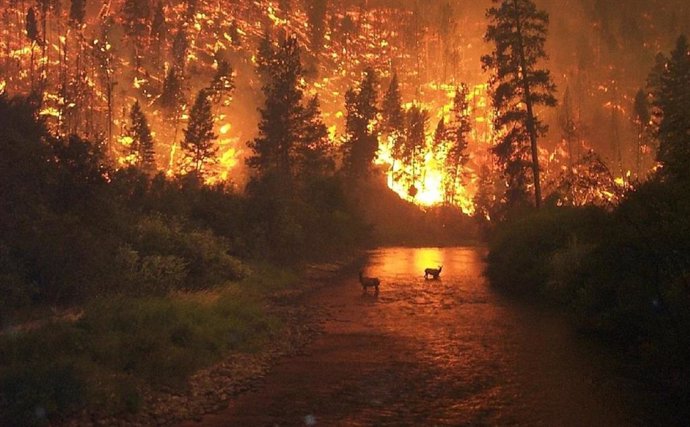Cleaning up air pollution caused by aerosols would cause more wildfires if there is no effort to also mitigate greenhouse gases. – JOHN MCCOLGAN/WIKIMEDIA COMMONS
May 29. () –
A new study has found that reducing levels of artificial aerosols paradoxically causes an increase in forest fires, especially in the forests of the northern hemisphere.
This includes forests in Canada, Alaska, northern Europe and northern Russia.
Aerosols are small particles such as dust and sea salt, as well as airborne chemicals produced by burning fossil fuels. They are responsible for poor air quality.
Because aerosol particles like sulfate and its precursors like sulfur dioxide reflect sunlight and help make clouds brighter, removing them means more heat from the sun reaches the ground, research from the University of California Riverside (UCR), published in Science Advances.
“Cleaning the air, which is something we all want to do, will accelerate global warming and also affect forest fires unless we also reduce emissions of greenhouse gases like methane and carbon dioxide“said Robert Allen, professor of climatology at UCR and lead author of the study.
The warming effect of atmospheric carbon dioxide levels is well known. The burning of fossil fuels for heating, electricity and transportation is adding increasing levels of CO2 to the atmosphere. CO2 acts like a blanket, preventing heat from leaving the Earth.
Heat waves and droughts occur more frequently in today’s climate than they did 50 years ago. These conditions cause plants to die and become fuel for forest fires.
“When the soil dries out, so do the plants, which makes them more combustible,” Allen said. it’s a statement. “Warming contributes to wildfires.”
Both CO2 and aerosol reductions cause warming and lead to large increases in wildfires. However, reducing aerosol emissions leads to more fires.
“We typically associate fire activity with increased heat: drier conditions, increased combustibility, etc.,” Allen said. “But in our experiments we saw that although increases in CO2 cause a greater increase in temperatures, there is actually a greater increase in fire activity with aerosol mitigation.”
As plants convert light into food in a process called photosynthesis, they use CO2. With more CO2 in the atmosphere, plants don’t have to keep their leaf pores open for as long to get the CO2 they need. Keeping pores closed allows them to retain more water. It also means that plants don’t need to extract as much water from the soil.
This implies that under aerosol mitigation, plants become drier. As fewer cooling sprays make conditions warmer, more water evaporates from plant pores. As plants lose water, they have to extract more water from the soil, which also leads to drier soil.
It is noteworthy that human-made aerosols have a short shelf life. “If aerosol emissions were stopped today, they would disappear from the atmosphere in a week,” Allen said.
Globally, there has been progress in reducing sulfate aerosols resulting from sulfur dioxide emissions. The United States and Europe have significantly reduced coal combustion. The remaining coal-fired power plants now use “scrubbing” technology that prevents these chemicals from forming. “This is good for air quality, but potentially bad for the climate,” Allen stated.
A faster way to offset warming induced by aerosol mitigation would be to make significant reductions in methane emissions from agriculture, fossil fuels, and landfill waste.
Methane warms the planet 86 times more powerfully than carbon dioxide, but has a much shorter half-life. Methane only lasts about a decade, compared to CO2, which can potentially last thousands of years.
“The warming that would come from reducing aerosols could be offset by reducing enough methane,” Allen said.
More than 150 countries have signed a commitment to reduce methane emissions by at least 30 percent from 2020 levels by 2030. Participants account for more than half of all human-caused methane emissions, so it is an achievable goal.
“We are on the right trajectory with respect to aerosols and methane. I am still hopeful, but there is a small window of time for this to happen to avoid the worst projected climate impacts,” Allen said. “This decade is the important one.”











![[Img #74129]](https://thelatestnews.world/wp-content/uploads/2024/10/Can-plants-hear-300x200.jpg)

Add Comment